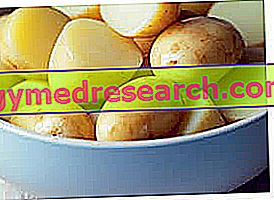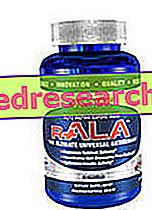Generality
Potatoes are tubers which, to gain edibility and digestibility, MUST be cooked.
Boiled potatoes are a dish characterized by great ease of preparation and nutritional characteristics quite far from those of a simple "side dish".

Let's clarify the concept by reporting one of the various recipes for potato salad.
Recipes: Potato Salad VS Potatoes Lesse
Ingredients for potato salad: medium-sized potatoes (150-200g each), fresh parsley (or rocket), fruity-light extra virgin olive oil and fine salt. At discretion: fresh garlic and / or pepper and / or sweet paprika.
Procedure for potato salad: Arrange the washed potatoes in a saucepan with plenty of tasteless water; over high heat, bring the water to a boil and boil everything for 20 'for every 100g of weight of the single potato (in this case 30-40'). Meanwhile, wash the parsley (or rocket) and chop it; in the event, peel a clove of garlic, clean it and finely chop it (or leave it whole for squeezing); add the EVO oil, salt to QB, parsley (or rocket) and possibly the optional ingredients. At the end of cooking (to be verified by threading the tubers with a fork, which will have to pass through easily), drain and let cool. Once at a temperature that allows the manipulation of the boiled potatoes, peel them and let them cool completely; then, cut them to the desired size and season with the previously prepared mixture.
Ingredients for boiled potatoes: medium potatoes (150-200g each).
Preparation for boiled potatoes: Arrange the washed potatoes in a saucepan with plenty of tasteless water; over high heat, bring the water to a boil and boil the whole for about 35'-45 '; drain at the end of cooking (to be verified by threading the tubers with a fork, which will have to pass through easily).
Boiled Potatoes - All Tricks for Boiling Potatoes
X Problems with video playback? Reload from YouTube Go to Video Page Go to Video Recipes Section Watch the video on youtubePotatoes Lesse: Pre-cooked Ingredient
In the previous paragraph I defined potatoes cooked as a precooked ingredient; readers will not be surprised if this attribution is not due to any cooking or gastronomy manual, it is in fact a definition that I associate myself with those raw materials that NECESSARY an independent thermal processing with respect to the recipe in which they are used. Also in this case, to facilitate understanding of this subtlety it is necessary to give a small example of the applicative difference between raw potatoes and boiled potatoes.
While raw potatoes are a basic product for the formulation of dishes that REQUIRE an entire process starting from the raw raw materials (for example, the "fish in a crust of potatoes", where the tubers are cut into chips and laid raw on the skin of the animal to bake), boiled potatoes are a pre-cooked ingredient and useful for the preparation of recipes that need the tuber COMPLETELY AND UNIFORMLY COOKED. This necessity arises, in most cases, in the case in which the other ingredients do NOT require a heat treatment comparable or overlapping to that of the potatoes. A trivial example is the "classic mashed potatoes", which requires the preparation of boiled potatoes to be peeled and crushed before being added to other ingredients (boiling the potatoes in the milk would lead to the coagulation of the proteins, longer processing times and a final result less pleasant).
Another example of a precooked ingredient is the legume in a jar; the only difference is that boiled potatoes have a short shelf life and do not contain high sodium or other preservatives.
Boiled potatoes are therefore both the basis for the formulation of potato salad, and an extremely ductile ingredient from which to obtain QUICKLY: puree, gnocchi, velvety, "fast" sauteed potatoes, etc. For a "good cook", keeping boiled potatoes in the fridge is a more than usual habit.
The Potatoes Lesse are NOT "Potatoes Bianchite"
Also the blanched potatoes represent a pre-processed form, but their cooking level is almost exclusively PARTIAL. Like the boiling of pre-cooked potatoes, the whitening also has the function of adjusting the cooking times; however, the whitening of the potatoes is applied in a diametrically opposite manner to the boiling. First of all, boiled potatoes are products to be considered totally EDULI, while whitish potatoes NO. The latter are minimally cooked and necessarily require further heat submission; then, from the methodological point of view, the boiled potatoes are immersed in cold water whole and then left to boil, on the contrary, the whitish ones are peeled, peeled, cut and thrown in boiling water for a few minutes (ie until they tend to fade MA do not change its consistency). A big difference!
Why are boiled potatoes cooked whole and not peeled and cut into pieces?
In reality, one could also opt for the latter method ... but the result would certainly not be the same! The whole and peel cooking has the very important function of NOT letting the potato starch dilute, instead it is more dispersed in the cooking of the cut tuber.
Quality and Nutrients
What's to Know about the Potatoes Read for Potato Salad?
Let's start by pointing out that, unlike other preparations such as gnocchi and mashed potatoes, salad boiled potatoes are not subject to VINCOLO in the qualitative choice. I suggest to prefer the most palatable ones (personal tastes), without dwelling on chemical details such as the density of the starch, its structure, the quantity of water, etc. On the contrary, it is much more important to respect the cooking and vegetable processing times. In addition to the precautions described above, some useful information is:
- The potatoes must NEVER sprout. The green portions of the plant contain a toxin called solanine (a glycoalkaloid) that can cause adverse reactions in the gastro-intestinal tract.
- Boiled potatoes are NOT peeled; this detail is more of a gastronomic nature because, in medium portions (2-3 grams), the peel of EDULI (not sprouted) and well-cooked potatoes should not be harmful to health. The only potato in which, in theory, it is allowed to use the peel for food purposes is "the new potato"; however, in the potato salad recipe, it is always a good idea to exclude it.
- In general, always choose potatoes with a more yellow flesh than white ones. The color difference is given by the content of carotenoids, or provitamins with antioxidant function.
- Even better if the potatoes in question are enriched with selenium and / or iodine, or are grown in soils integrated with these minerals. Selenium is a powerful antioxidant and, synergistically with iodine, plays a protective role for the thyroid.
The nutritional characteristics comparable to all the potatoes are:
- Energy richness (about 85kcal / 100g), almost totally supplied by starch
- High glycemic index, increased by the duration of cooking due to starch hydrolysis
- Rich in potassium, iron and niacin
- Water and dietary fiber scarcity
Ultimately, boiled potatoes are a highly energetic food (therefore unsuitable in the low-calorie diet) that brings significant amounts of starch (from which the "potato starch" is derived). Moreover, they have a rather high glycemic index, therefore they are not advisable in feeding the diabetic type 2 subject. When consumed, they are more suitable to replace foods such as pasta and bread (but in portions about 4 times higher), or, in modest quantities (100-150g) lend themselves to accompanying only low-calorie dishes (eg. octopus and other molluscs, eggs, very lean cheeses and certain white meats).



